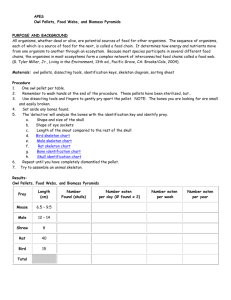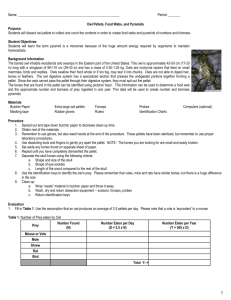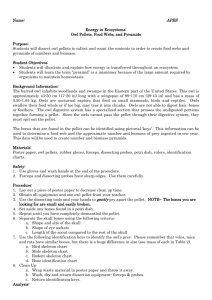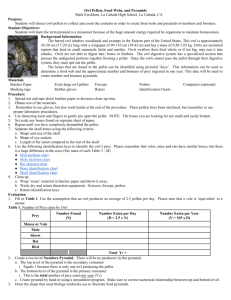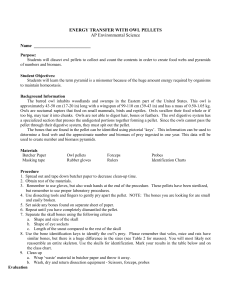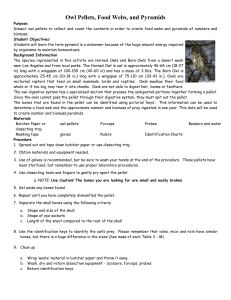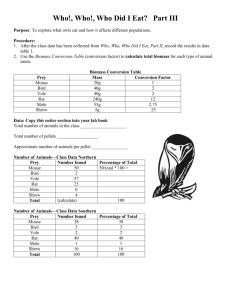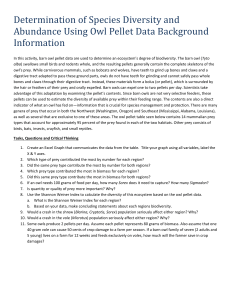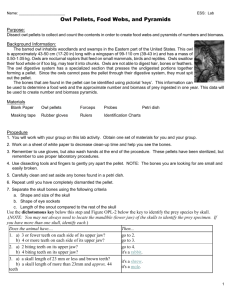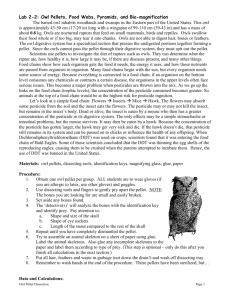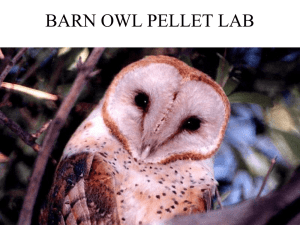Owl Pellets, Food Webs, and Pyramids Lab
advertisement
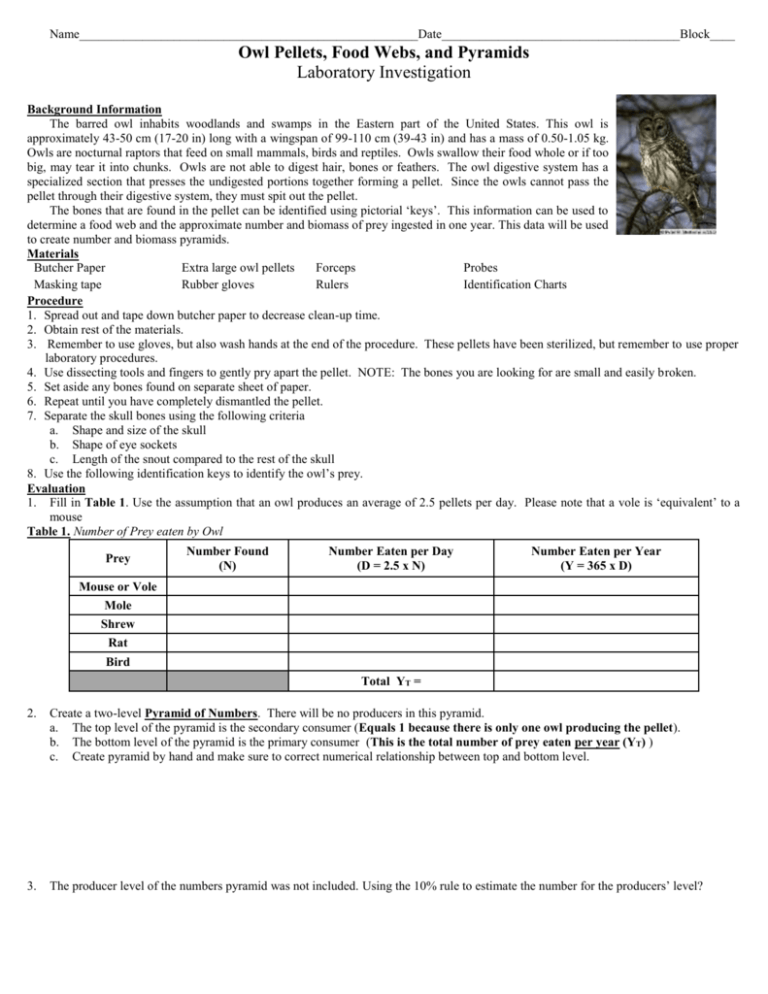
Name______________________________________________________Date______________________________________Block____ Owl Pellets, Food Webs, and Pyramids Laboratory Investigation Background Information The barred owl inhabits woodlands and swamps in the Eastern part of the United States. This owl is approximately 43-50 cm (17-20 in) long with a wingspan of 99-110 cm (39-43 in) and has a mass of 0.50-1.05 kg. Owls are nocturnal raptors that feed on small mammals, birds and reptiles. Owls swallow their food whole or if too big, may tear it into chunks. Owls are not able to digest hair, bones or feathers. The owl digestive system has a specialized section that presses the undigested portions together forming a pellet. Since the owls cannot pass the pellet through their digestive system, they must spit out the pellet. The bones that are found in the pellet can be identified using pictorial ‘keys’. This information can be used to determine a food web and the approximate number and biomass of prey ingested in one year. This data will be used to create number and biomass pyramids. Materials Butcher Paper Extra large owl pellets Forceps Probes Masking tape Rubber gloves Rulers Identification Charts Procedure 1. Spread out and tape down butcher paper to decrease clean-up time. 2. Obtain rest of the materials. 3. Remember to use gloves, but also wash hands at the end of the procedure. These pellets have been sterilized, but remember to use proper laboratory procedures. 4. Use dissecting tools and fingers to gently pry apart the pellet. NOTE: The bones you are looking for are small and easily broken. 5. Set aside any bones found on separate sheet of paper. 6. Repeat until you have completely dismantled the pellet. 7. Separate the skull bones using the following criteria a. Shape and size of the skull b. Shape of eye sockets c. Length of the snout compared to the rest of the skull 8. Use the following identification keys to identify the owl’s prey. Evaluation 1. Fill in Table 1. Use the assumption that an owl produces an average of 2.5 pellets per day. Please note that a vole is ‘equivalent’ to a mouse Table 1. Number of Prey eaten by Owl Prey Number Found (N) Number Eaten per Day (D = 2.5 x N) Number Eaten per Year (Y = 365 x D) Mouse or Vole Mole Shrew Rat Bird Total YT = 2. Create a two-level Pyramid of Numbers. There will be no producers in this pyramid. a. The top level of the pyramid is the secondary consumer (Equals 1 because there is only one owl producing the pellet). b. The bottom level of the pyramid is the primary consumer (This is the total number of prey eaten per year (YT) ) c. Create pyramid by hand and make sure to correct numerical relationship between top and bottom level. 3. The producer level of the numbers pyramid was not included. Using the 10% rule to estimate the number for the producers’ level? 4. Fill in Table 2. Note: Number of prey per year (Y) is from Table 1. Table 2. Biomass of Prey and Producers Prey Number of Prey/year (Y) Mass (kg) (M) Mass of Prey (PM = Y x M) Mass (kg) of Producers eaten by Prey (Prod) Mouse 0.020 45.6 Mole 0.055 365 Shrew 0.005 1168 Rat 0.240 12.8 Bird 0.020 127 Total PMT (kg) Total Biomass of Producers BMT (kg) Biomass of Producers (BM = PM x Prod) 5. Use your calculations from Table 2 to create a three-level Pyramid of Biomass. a. The secondary consumer (top-level) is the Barred Owl and its approximate biomass is indicated in the section called Background Information. b. The biomass of all primary consumers (middle-level) is the Total Mass of the Prey (PMT). c. The biomass of all producers (bottom-level) is the Total Biomass of the Producers (BMT). 6. Does the shape of the pyramid illustrate the of the 10% rule? Which pyramids (numbers or biomass) more accurately reflect the 10% rule concept? Table 3. Owl prey and their respective diet Prey Mouse Mole Shrew Rat Bird Diet It eats a wide variety of plant and animal matter depending on what is available, including insects and other invertebrates, seeds, fruits, flowers, nuts, and other plant products. A mole's diet is mostly insects and other invertebrates, including earthworms, centipedes, millipedes, snails, slugs, grubs, ants, sowbugs, termites, beetles, and crickets Food habit studies have revealed that shrews eat beetles, grasshoppers, butterfly and moth larvae, wasps, crickets, spiders, snails, earthworms, slugs, centipedes, and millipedes. Shrews also eat small birds, mice, small snakes, and even other shrews when the opportunity presents itself. Seeds, roots, and other vegetable matter are also eaten by some species of shrews. The rat's diet typically includes seeds, nuts, grains, vegetables, fruits, meats and invertebrates. They consume about one-third of their weight in food every 24 hours. Because of their inability to vomit, rats are very hesitant to try new foods that may be poisonous. They will take a small nibble and wait to see if they feel sick and, if so, will avoid that food in the future. insects; terrestrial non-insect arthropods, seeds, grains, and nuts; fruit 7. On a separate sheet of paper use the information from Table 3 to draw a Food Web that is representative of your pellet. a. Draw and label the ___________as the top consumer. b. Draw and label all prey found in the feces as the next level of consumer. c. Draw and label any consumers eaten by the prey (use table to see where their energy comes from!). d. Draw and label any producers eaten by prey or any producers eaten by consumers eaten by prey (use table to see where their energy comes from!). e. Draw ‘energy’ arrows to show the flow of energy going from on organism into another organism (there may be many connections!) Conclusion Question 8. What would happen to the number of prey if the owl was removed due to something like habitat destruction? What would happen to the number of producers? 9. Which organism is probably responsible for keeping the food web and the pyramids in their respective shapes? The Earth is an open system for energy. Explain what that means using evidence from pyramids. 1. Does your data support the First Law of Thermodynamics (energy is never destroyed only transformed into another form)? 2. Does your data support the Law of Conservation of Matter (matter is never destroyed only transformed into another form) ?
